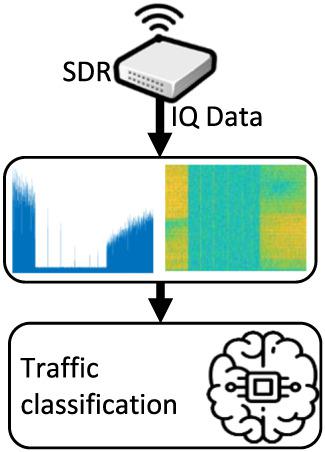当前位置:
X-MOL 学术
›
Int. J. Netw. Manag.
›
论文详情
Our official English website, www.x-mol.net, welcomes your feedback! (Note: you will need to create a separate account there.)
Traffic classification at the radio spectrum level using deep learning models trained with synthetic data
International Journal of Network Management ( IF 1.5 ) Pub Date : 2020-02-24 , DOI: 10.1002/nem.2100 Tom De Schepper 1 , Miguel Camelo 1 , Jeroen Famaey 1 , Steven Latré 1
International Journal of Network Management ( IF 1.5 ) Pub Date : 2020-02-24 , DOI: 10.1002/nem.2100 Tom De Schepper 1 , Miguel Camelo 1 , Jeroen Famaey 1 , Steven Latré 1
Affiliation

|
Traffic recognition is commonly done using deep packet inspection or packet‐based approaches. However, these methods require the listening device to be part of the network and raise privacy concerns. Traffic recognition models that operate directly at the spectrum level could, for instance, be used for smart spectrum management. To this extent, we present such an approach using deep learning methods. In particular, we present a convolutional neural network architecture that forms the basis for prediction models to recognize different transport protocols, burst traffic with different duty cycles, and different transmission rates. These models are trained with pure synthetic data to lighten the burden of data collection. As such, we validate recent successes in the area of robotics in the context of wireless networks. We compare the performance of two different datasets that contain spectrum images in either time or time‐frequency domain. Our evaluation shows that using time domain data results in an accuracy of at least 96% across all models. Time‐frequency information improves this accuracy even further. Furthermore, a validation with real‐life data shows that it is still possible to discriminate between different transmission rates with an accuracy of around 87%, while the detection of duty cycles and transport protocols takes place with accuracies of, respectively, around 73% and 78%. Finally, we also present a small‐scale real‐life prototype.
中文翻译:

使用综合数据训练的深度学习模型在无线电频谱级别进行流量分类
流量识别通常使用深度数据包检查或基于数据包的方法来完成。但是,这些方法要求侦听设备成为网络的一部分,并引起隐私问题。直接在频谱级别运行的流量识别模型可用于例如智能频谱管理。在这个程度上,我们提出了一种使用深度学习方法的方法。特别是,我们提出了卷积神经网络体系结构,该体系结构构成了预测模型的基础,以识别不同的传输协议,具有不同占空比的突发流量和不同的传输速率。这些模型使用纯合成数据进行训练,以减轻数据收集的负担。因此,我们验证了无线网络环境下机器人技术领域的最新成就。我们比较了包含时域或时频域中频谱图像的两个不同数据集的性能。我们的评估表明,使用时域数据在所有模型中的准确性至少为96%。时频信息进一步提高了此准确性。此外,根据实际数据进行的验证表明,仍然有可能以87%左右的准确度区分不同的传输速率,而占空比和传输协议的检测分别以大约73%和90%的准确性进行。 78%。最后,我们还提出了一个小规模的现实生活原型。时频信息进一步提高了此准确性。此外,根据实际数据进行的验证表明,仍然有可能以87%左右的准确度区分不同的传输速率,而占空比和传输协议的检测分别以大约73%和90%的准确性进行。 78%。最后,我们还提出了一个小规模的现实生活原型。时频信息进一步提高了此准确性。此外,根据实际数据进行的验证表明,仍然有可能以87%左右的准确度区分不同的传输速率,而占空比和传输协议的检测分别以大约73%和90%的准确性进行。 78%。最后,我们还提出了一个小规模的现实生活原型。
更新日期:2020-02-24
中文翻译:

使用综合数据训练的深度学习模型在无线电频谱级别进行流量分类
流量识别通常使用深度数据包检查或基于数据包的方法来完成。但是,这些方法要求侦听设备成为网络的一部分,并引起隐私问题。直接在频谱级别运行的流量识别模型可用于例如智能频谱管理。在这个程度上,我们提出了一种使用深度学习方法的方法。特别是,我们提出了卷积神经网络体系结构,该体系结构构成了预测模型的基础,以识别不同的传输协议,具有不同占空比的突发流量和不同的传输速率。这些模型使用纯合成数据进行训练,以减轻数据收集的负担。因此,我们验证了无线网络环境下机器人技术领域的最新成就。我们比较了包含时域或时频域中频谱图像的两个不同数据集的性能。我们的评估表明,使用时域数据在所有模型中的准确性至少为96%。时频信息进一步提高了此准确性。此外,根据实际数据进行的验证表明,仍然有可能以87%左右的准确度区分不同的传输速率,而占空比和传输协议的检测分别以大约73%和90%的准确性进行。 78%。最后,我们还提出了一个小规模的现实生活原型。时频信息进一步提高了此准确性。此外,根据实际数据进行的验证表明,仍然有可能以87%左右的准确度区分不同的传输速率,而占空比和传输协议的检测分别以大约73%和90%的准确性进行。 78%。最后,我们还提出了一个小规模的现实生活原型。时频信息进一步提高了此准确性。此外,根据实际数据进行的验证表明,仍然有可能以87%左右的准确度区分不同的传输速率,而占空比和传输协议的检测分别以大约73%和90%的准确性进行。 78%。最后,我们还提出了一个小规模的现实生活原型。


























 京公网安备 11010802027423号
京公网安备 11010802027423号